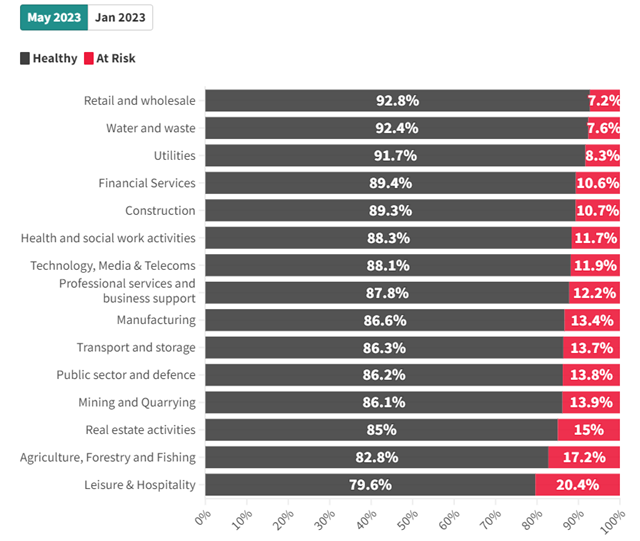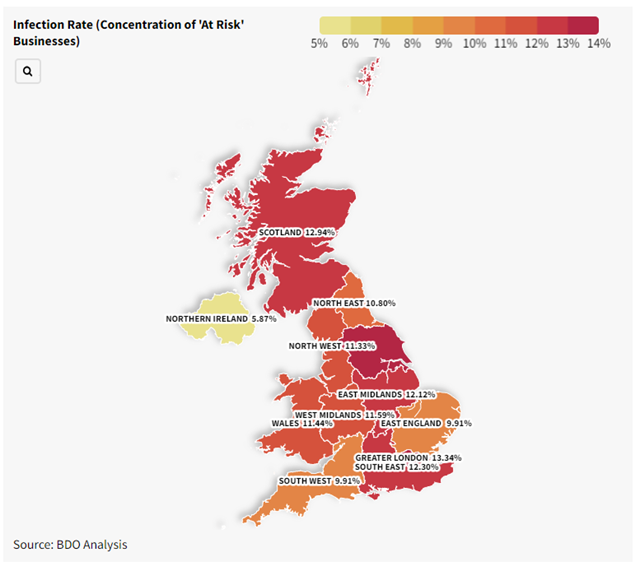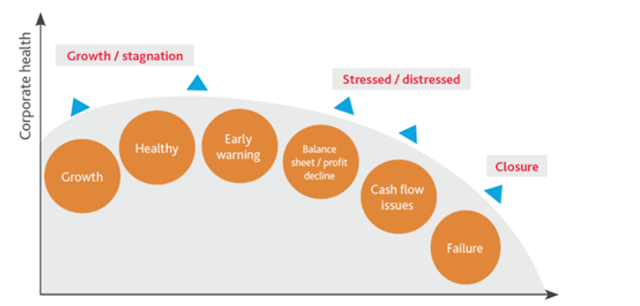Original content provided by BDO United Kingdom
- ‘Zombies’ are companies that generate just enough cash to continue operating and service their debt but not to invest in growth
- There is growing concern that historically low interest rates have been enabling underperforming companies to limp on without being forced to restructure. Is the UK’s mid-market full of ‘Zombie’ businesses and how is this changing over time?
- BDO analysis shows that, although the number of mid-market businesses ‘at risk’ of being a so-called ‘Zombie’ is fairly static, the number of firms is still significant
- Having analysed businesses in the £10m to £500m turnover bracket, we found that of the 15,000 businesses reviewed just under 12% could be deemed ‘at risk’ of being or becoming a ‘Zombie’. This is slightly down on the 12.7% reported in our January 2023 tracker
- Geographically, the concentration of ‘at risk’ businesses is fairly consistent across the UK. Greater London, Yorkshire & The Humber, and Scotland had the most ‘at risk’ businesses as a proportion of the total number. Norther Ireland is an outlier, with a very low proportion of ‘at risk’ businesses
- Companies that are currently at risk with low profitability and high debt burdens need to address their resilience and take action
Our latest tracker continues to assess the number of businesses within the UK mid-market that are ‘at risk’ of being so-called ‘Zombies’, detrimentally impacting the UK’s productivity stagnation and economic growth.
Since our last analysis, output and optimism in service-based sectors rose to an eight-month high whilst manufacturing optimism fell to Covid era levels - according to BDO’s latest Business Trends analysis, but has this trend been reflected in the latest ‘Zombie’ data?
What is a ‘zombie company’?
‘Zombies’ are companies that generate just enough cash to continue operating and service their debt but not to invest in growth. In the current economic climate, there is growing concern amongst commentators that historically low interest rates have been enabling underperforming companies to limp on without being forced to restructure.
These low interest rates and the potential willingness of lenders to show forbearance to unprofitable companies is said to be damaging productivity and undermining competitiveness.
The above, coupled with high inflation eating away at margins and testing what are historically sound business operating models, is resulting in reduced confidence, weakening recovery plans and, importantly, is testing the resolve of lenders.
Navigating this landscape will be a challenge and restructurings are likely to be common. This will not only impact jobs in individual firms, but it will also affect businesses in the interconnected supply chain and local economies.
"Persistently low borrowing rates over the last decade have meant that cheap credit may have enabled underperforming businesses to persevere rather than restructure. What we see now, however, is that refinancing to restructure will likely be more costly. With a recession on the cards, businesses that see their sales materially drop are going to find it more difficult to service their debts and refinance. As such, businesses must review their resilience now and act.” – Ross McWhir, Value Creation Services."
Despite the challenging environment, there will be an opportunity for strong and well-run businesses to consolidate their market positioning, embed resilience and take advantage of a fragmented outlook.
We continue to define a business as ‘at risk’ if both of the following criteria are met:

The latest trends – what’s changed?
Having analysed businesses in the £10m to £500m turnover bracket, we found that of the 15,000 businesses reviewed just under 12% could be deemed ‘at risk’ of being or becoming a ‘Zombie’. This is slightly down on the 12.7% reported in our January 2023 tracker
Possible causes of this stability and slight reduction include:
- Previously ‘at risk’ rebounding thanks to the effect of post-covid growth and returning optimism in the UK economy
- Zombie businesses having ceased to trade or entered a formal insolvency process
- Growth or shrinkage of revenues removing the businesses from the original data set

Leisure & Hospitality remains the most at risk industry despite a 2.8 percentage point decrease compared to our last tracker was published. High inflation, labour shortages and diminished discretionary spend due to consumer confidence challenges continue to bite the sector.
These businesses heavily depend on consumer confidence and discretionary spending, both of which are weakening. Consumer economic concerns and the perception of rising prices for essential goods like energy, fuel, food, and transportation expenses, are eroding discretionary spending, especially among low and middle-income households.
Initially, it was expected that household spending would rebound after two years of below-average growth levels as the risks related to Covid-19 subsided. However, the combination of high inflation and limited growth in real wages has diminished consumers' purchasing power, posing risks to this optimistic outlook. Consequently, the recovery of the leisure and hospitality sector could be affected.
"Manufacturing: “whilst there has been a marginal improvement in the percentage of “at risk” companies in the Manufacturing sector, it should be noted that the data set is smaller; the number of manufacturing companies in the mid-market shrank by 1.2% in the period since our first article. There has been an increase in insolvencies in the sector (18% for the 4 months to April 2023 versus the same period last year) and I believe it is likely that this is behind the 1.2% reduction, as the weaker companies start to fail. Companies in the sector should take stock as soon as possible to ensure they take any action necessary to preserve the business” Ben Peterson, Business Restructuring.
Real Estate Activities has likely been negatively impacted by higher mortgage costs, making it more expensive for borrowers to finance their real estate purchases. This would have further resulted in real estate businesses requiring refinancing, to endure unfavourable increases in financing costs. This can also have a knock-on effect on demand for housing, reducing the price real estate companies can demand for their developments.
Agriculture, Forestry and Fishing has been another adversely affected sector since the last tracker was published - it is now the second highest ‘at risk’ industry. The challenges of Brexit, supermarket pressure and workforce shortages continue to present a challenging outlook for businesses in this sector.
Retail & Wholesale continues to display a low percentage of ‘at risk’ businesses. A full year free of restrictions and stability in shopping patterns likely contributing to the relative strength of this sector. This may begin to change in future trackers, however, as retailers and wholesalers feel the strain of more prolonged high inflation and the consumer spending challenges that are damaging the Leisure & Hospitality sectors. There also remains a sizeable variance between wholesale businesses and retail businesses, who have likely faced different challenges of late.
What regions are most ‘at risk’?
Our graphic below looks at the proportion of ‘at risk’ businesses within each UK geographic region using a registered office information.
Geographically, the concentration of ‘at risk’ businesses is fairly consistent across the UK. Of the twelve regions, eight have an ‘at risk’ percentage between 11% and 14%, three have an ‘at risk’ percentage between 9% and 11% and Norther Ireland was one outlier with an ‘at risk’ percentage of on 5.9%, albeit from a small sample size.
Greater London, Yorkshire & The Humber, and Scotland were the three highest ‘at risk’ regions.

Somewhat surprisingly, Greater London has the highest percentage of ‘at risk’ businesses at over 13%, albeit the data is likely skewed by businesses having their registered office in the region but core operations spread across the UK.
Drivers of the difficulties being felt in the Capital are the proportion of business in the Leisure, Hospitality, Retail and Wholesale sectors that have an above national-average ‘at risk’ rate. Businesses are telling us the slow recovery of employees returning to work and the intense competition experienced in these sectors within London are potential causal reasons.
Two competing dynamics are the London-area’s reliance on Professional / Business Services and Financial Services. The latter, representing a third of all businesses in London’s mid-market, has an ‘at risk’ score of 13.3%, one percentage point higher than the national average. Conversely Financial Services businesses in the Capital are less likely to be ‘at risk’ with a percentage of 8.8% versus a national average of 10.6%.
The picture is similar in Scotland, the third highest in terms of percentage of ‘at risk’ businesses by region (12.94%), where Professional / Business Services make up a significant minority of the mid-market and are displaying high than national average challenges.
Real estate activities, although only representing a minority of businesses in the region, has a significant ‘at risk’ percentage in London of 24% versus the national average 15%. A slowing property and office rental market could explain this.
Yorkshire and The Humber has the second highest concentration of ‘at risk’ businesses (13.22%). Across 11 of the 14 industries, the region has an above national-average percentage of ‘at risk’ businesses.
The region also has a high proportion of manufacturing businesses which is pushing up the average.
Our data coupled with ONS data that unemployment rates in the region are not reducing in line with national average and the portion of the working age population that are economically inactive has risen paints a picture that the outlook is challenging for mid-market businesses in Yorkshire and The Humber.
Business turnaround: what do at risk firms need to do?
Whilst our analysis shows the number of firms ‘at risk’ may be lower than expected, there is still a significant minority that may not be well-positioned to enter choppy waters. Companies that are currently at risk with low profitability and high debt burdens need to address their resilience and take action.
The strength of company balance sheets often depends on the level of funds shareholders have taken out as dividends, the amount of debt taken, or the amount invested in new products and assets. This will impact a company’s options and the time available to implement changes or turnaround actions.
It is likely that most ‘at risk’ businesses will have reluctantly moved further to the right on the corporate decline curve as a result of recent economic challenges – see chart below.

In general, businesses responded well to the impact of geopolitical tension, COVID-19 and Brexit. They focused on minimising the effects on business operations by reducing costs, preserving cash, seeking additional funds to plug short-term funding gaps and implementing necessary health and safety measures to ensure employee safety.
However, most businesses will require more transformational action to ensure they can prime themselves to survive the coming economic turbulence. We highlight below some of the short-term actions that we have advised clients to implement. Addressing these issues now has been fundamental to a business’ longer-term health and protecting shareholder value.
- Rigorously challenge the cost base – attempt to eliminate non-essential expenditure and implement processes and controls to discourage needless spend
- Assess product/service mix and reduce focus and management time spent on weaker products and services
- Undertake a rapid assessment of the business’s pricing strategy – optimised pricing is the quickest way to bottom line improvement. Consider segmenting your customer base, focussing on 80/20 principles, and making use of targeted discounts and promotions
- Consider mothballing production assets and sites that offer little contribution but add complexity
- Challenge the organisation structure and, if appropriate, reduce headcount costs through short-term working and laying off
- Comprehensively challenge usefulness of time-consuming tasks and reporting, ceasing those which add little value
Numerous companies are hoping that a downturn may be short lived and governmental measures will support the economy. However, with the risk that a potential downturn may be prolonged, for ‘at risk’ businesses to survive in the medium to long term, more fundamental actions are likely to be required.
Below we highlight some of the actions we encourage businesses to take to implement more structural, permanent changes to their business operating models.
Implementing one or a combination of these actions requires a business transformation programme and it is likely that management teams will require additional support to define, plan and implement agreed actions. Additional or alternative funding may also be required to finance the business transformation.
- Downsize the organisational structure in operational and back-office functions. This would involve eliminating roles, de-layering management levels and merging functions to reduce the number of staff in the business
- Assess the intellectual property or technical transfer your business’ products or services provide. This could involve ceasing the production of non-core or low value products, and investing in new products and services in more resilient and profitable business sectors
- Restructure the business by closing sites or locations. This could involve exiting UK and international factories or offices and consolidating production locations, as well as assessing the impact of the exit from the EU
- Challenge all back-office processes and consider levels of automation vs manual activity, quality of output, and identify core process weaknesses
- Undertake a comprehensive review of your finance function and its potential weaknesses. This can help to dramatically improve cashflows. Businesses that are struggling may have to become imaginative with ways of dealing with current cash, credit and debit balances (such as considering debt factoring, offering customer incentives, following up with invoice reminders)
- Insource production or services from sub-contractors. This could utilise spare production capacity within your existing manufacturing footprint
- Periodically prune your business by divesting slow-growing parts and reinvesting the proceeds into new areas. For companies that do not see consistent growth, trying to boost performance with a one-time large acquisition should be discouraged
- Divest underperforming business areas, or wind them up if they are not sellable. This would allow your business and management team to focus on more profitable operations
- Consolidate and de-risk your supply chain. This would involve reducing suppliers to maintain volumes with a smaller number of key suppliers, and relocating the supply base closer to home to reduce the risk of supply interruption
- Acquire businesses and integrate operations to boost turnover and profitability. This would boost scale, productivity and allow significant savings
- Consider the provisions of the CIGA to protect your business from creditors whilst a turnaround plan is implemented.
The restructuring provisions within the recently introduced Corporate Insolvency and Governance Act 2020 (‘CIGA’) are a welcome addition to already available restructuring tools, especially as these are debtor-led, allowing the company to control the restructuring process. These new tools grant businesses a level of moratorium protection as they navigate their way out of the current environment. However, the use of these protections requires early intervention to allow time to create a viable financial and operational restructuring plan.
Although the current economic environment is having a significant impact on the mid-market, we would suggest that companies should respond positively to the challenges and use instability as a catalyst for change, and an opportunity to build resilience into their operations. Many of our clients have already embarked on this journey and are actively in the process of reshaping their businesses.
To discuss how your business can build its resilience, please contact David Warnock.